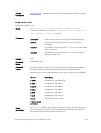
Usage
Information
To enable robust, effective protection and security for SNMP packets transferred
between the server and the client, you can use the snmp-server user
username group groupname 3 auth authentication-type auth-
password priv aes128 priv-password to specify that AES128-CFB
encryption algorithm needs to be used.
You cannot modify the FIPS mode if SNMPv3 users are already configured and
present in the system. An error message is displayed if you attempt to change the
FIPS mode by using the fips mode enable command in Global Configuration
mode. You can enable or disable FIPS mode only if SNMPv3 users are not
previously set up. Otherwise, you must remove the previously configured users
before you change the FIPS mode.
Example
Dell# snmp-server user privuser v3group v3 encrypted auth md5
9fc53d9d908118b2804fe80e3ba8763d priv aes128
d0452401a8c3ce42804fe80e3ba8763d
Related
Commands
show snmp user — Displays the information configured on each SNMP user name.
snmp-server vrf
Configures an SNMP agent to bind to a specific VRF.
Syntax
snmp-server vrf vrf-name
To undo the SNMP agent configuration, use the no snmp-server vrf vrf-
name command.
Parameters
vrf vrf-name Enter the keyword vrf and then the name of the VRF to
associate an SNMP agent with that VRF.
Defaults Not Enabled.
Command
Modes
CONFIGURATION
Command
History
This guide is platform-specific. For command information about other platforms,
refer to the relevant Dell Networking OS Command Line Reference Guide.
The following is a list of the Dell Networking OS version history for this command.
Version Description
9.7(0.0) Introduced on the S6000-ON.
9.4(0.0) Introduced on the S-Series and Z9000.
Usage
Information
Use this command to bind an SNMP agent to a VRF. The SNMP agent processes
the requests from the interfaces that belong to the specified VRF. If no VRF is
specified, then the default VRF is used.
1716
Simple Network Management Protocol (SNMP) and Syslog


















